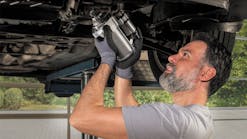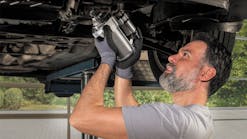Light vehicles, several truck classes in U.S. may need to make refrigerant changes
Car and truck manufacturers need to step on the gas when it comes to switching to more environmentally friendly refrigerants in their vehicles’ air conditioning systems. That’s the message the United States Environmental Protection Agency (EPA) delivered in Dec. 2022 when it proposed a rule change that would take effect beginning with 2025 and 2026 model years.
The proposed rule calls for manufacturers of several vehicle types to phase out the use of high-GWP hydrofluorocarbon (HFC) refrigerants that are currently used in their mobile air conditioning (AC) systems and convert to lower-GWP alternative refrigerants. These alternatives would include Solstice yf (HFO-1234yf), a hydrofluoroolefin (HFO) that has a reduced environmental footprint and has been certified under the Significant New Alternatives Policy (SNAP) as a suitable substitute for HFC-134a.
The latest EPA action is part of a sweeping plan under the American Innovation and Manufacturing (AIM) Act to drastically phase down HFCs used in aerosols, foams and refrigeration equipment, along with mobile and stationary AC systems. By accelerating its HFC reduction efforts, the United States joins the European Union in addressing a significant contributor to greenhouse gas emissions.
The goal of the EPA action is to drive down the use of HFCs in the United States from a baseline of about 300 million metric tons exchange value equivalent (MMTEVe). The phasedown schedule requires HFC consumption to be 40 percent below the baseline in 2024 and 70 percent below the baseline by the end of the decade.
To achieve these objectives, the government will severely limit the production and import of HFCs. As a consequence, vehicle makers who don’t move quickly could experience HFC supply limitations even before the model year 2025 or model year 2026 phaseout timing.
The clock is ticking particularly for carmakers because passenger cars (Class 1) and light-duty pickups (Class 2A) fall under the proposed guidelines beginning with the 2025 model year. The proposed rule would also phase out high-GWP HFCs in medium-duty passenger vehicles (Class 2A–2B), heavy-duty pickup trucks (Class 2B–3) and heavy-duty vans, (Class 2B–3) but starting in model year 2026.
Even though many carmakers have already converted most of their models to HFO-1234yf from HFC-134a refrigerant over the last five years, there are still some new car models sold in the United States today that use HFC-134a. These models will have to be converted to a low-GWP alternative for model year 2025 according to the new rule.
In an Accenture survey, two-thirds of drivers labeled themselves environmentally minded and 90 percent said they would even pay a premium for a more sustainable vehicle. Automakers continue to feel pressure from customers, regulatory authorities, dealers and other stakeholders to reduce the environmental impact of their products, operations and supply chains. As they prepare to take 2025 and 2026 models from the drawing board to the showroom, manufacturers need to develop an effective strategy to significantly reduce their reliance on HFC refrigerants in their cars and trucks.
Unlike HFC-134a, which is a highly potent greenhouse gas, HFO-1234yf has a reduced environmental impact. HFC-134a has a global warming potential (GWP) of 1,430 while HFO-1234yf has GWP of less than one, which means it traps less heat in the atmosphere than carbon dioxide with its GWP of 1. The switchover from HFC-134a to HFO-1234yf will continue to be easy for automakers and will go unnoticed by their customers because both materials are equally effective in all ambient temperatures.


